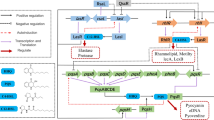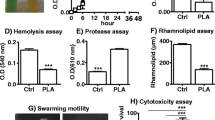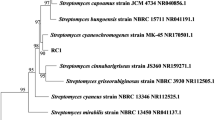Abstract
Quorum sensing (QS) regulates virulence factor expression in Pseudomonas aeruginosa. Inhibiting the QS-controlled virulence factors without inhibiting the growth of P. aeruginosa is a promising approach for overcoming the widespread resistance of P. aeruginosa. This study was proposed to investigate the effects of two novel synthetic peptides on the biofilm development and virulence factor production of P. aeruginosa. The tested strain was P. aeruginosa PAO1. The results indicated that both of the synthetic peptides (LIVRHK and LIVRRK) inhibited (P < 0.05) the formation of biofilms and the production of virulence factors, including pyocyanin, protease, and rhamnolipids, without inhibiting the growth of PAO1. Additionally, we detected transcriptional changes related to QS and found a significant reduction in the levels of gene expression of lasI, lasR, rhlI, and rhlR. This study demonstrates that LIVRRK and LIVRHK are novel synthetic peptides that can act as potent inhibitors of QS-regulated virulence factors in P. aeruginosa. Moreover, these synthetic peptides have potential applications in the treatment of biofilmrelated diseases. Both peptides may be able to control chronic infections and biofilm-associated problems of P. aeruginosa.
Similar content being viewed by others
References
Abdel-Mawgoud, A.M., Hausmann, R., Lépine, F., Müller, M.M., and Déziel, E. 2011. Rhamnolipids: detection, analysis, biosynthesis, genetic regulation, and bioengineering of production, pp. 13–55. In Biosurfactants, Springer, Berlin, Hdidelberg, Germany.
Andrejko, M., Zdybicka-Barabas, A., Janczarek, M., and Cytryńska, M. 2013. Three Pseudomonas aeruginosa strains with different protease profiles. Acta Biochim. Pol. 60, 83–90.
Ayora, S. and Götz, F. 1994. Genetic and biochemical properties of an extracellular neutral metalloprotease from Staphylococcus hyicus subsp. hyicus. Mol. Gen. Genet. 242, 421.
Azghani, A.O., Miller, E.J., and Peterson, B.T. 2000. Virulence factors from Pseudomonas aeruginosa increase lung epithelial permeability. Lung 178, 261–269.
Bala, A., Kumar, R., and Harjai, K. 2011. Inhibition of quorum sensing in Pseudomonas aeruginosa by azithromycin and its effectiveness in urinary tract infections. J. Med. Microbiol. 60, 300–306.
Balaji, K., Thenmozhi, R., and Pandian, S.K. 2013. Effect of subinhibitory concentrations of fluoroquinolones on biofilm production by clinical isolates of Streptococcus pyogenes. Indian J. Med. Res. 137, 963.
Brogden, K.A. 2005. Antimicrobial peptides: pore formers or metabolic inhibitors in bacteria? Nat. Rev. Microbiol. 3, 238.
Cherkasov, A., Hilpert, K., Jenssen, H., Fjell, C.D., Waldbrook, M., Mullaly, S.C., Volkmer, R., and Hancock, R.E.W. 2008. Use of artificial intelligence in the design of small peptide antibiotics effective against a broad spectrum of highly antibiotic-resistant superbugs. ACS Chem. Biol. 4, 65–74.
CLSI (Clinical and Laboratory Standards Institute). 2012. Performance standards for antimicrobial disk susceptibility tests; Approved standards. Wayne, PA: M100–S22.
De Kievit, T.R. 2009. Quorum sensing in Pseudomonas aeruginosa biofilms. Environ. Microbiol. 11, 279–288.
de la Fuente-Núñez, C., Cardoso, M.H., de Souza Cândido, E., Franco, O.L., and Hancock, R.E.W. 2016. Synthetic antibiofilm peptides. BBA-Biomembranes 1858, 1061–1069.
de la Fuente-Núñez, C., Korolik, V., Bains, M., Nguyen, U., Breidenstein, E.B.M., Horsman, S., Lewenza, S., Burrows, L., and Hancock, R.E.W. 2012. Inhibition of bacterial biofilm formation and swarming motility by a small synthetic cationic peptide. Antimicrob. Agents Chemother. 56, 2696–2704.
Déziel, E., Lépine, F., Milot, S., and Villemur, R. 2000. Mass spectrometry monitoring of rhamnolipids from a growing culture of Pseudomonas aeruginosa strain 57RP. Biochim. Biophys. Acta (BBA)-Mol. Cell Biol. Lipids 1485, 145–152.
Essar, D.W., Eberly, L., Hadero, A., and Crawford, I.P. 1990. Identification and characterization of genes for a second anthranilate synthase in Pseudomonas aeruginosa: interchangeability of the two anthranilate synthases and evolutionary implications. J. Bacteriol. 172, 884–900.
Fjell, C.D., Hiss, J.A., Hancock, R.E.W., and Schneider, G. 2012. Designing antimicrobial peptides: form follows function. Nat. Rev. Drug Discov. 11, 37.
Fuqua, C. and Greenberg, E.P. 2002. Signalling: listening in on bacteria: acyl-homoserine lactone signalling. Nat. Rev. Mol. Cell Biol. 3, 685.
Gonzâlez-Lamothe, R., Mitchell, G., Gattuso, M., Diarra, M.S., Malouin, F., and Bouarab, K. 2009. Plant antimicrobial agents and their effects on plant and human pathogens. Int. J. Mol. Sci. 10, 3400–3419.
Gupta, S., Sharma, A.K., Jaiswal, S.K., and Sharma, V.K. 2016. Prediction of biofilm inhibiting peptides: an in silico approach. Front. Microbiol. 7, 949.
Hancock, R.E.W. and Sahl, H.G. 2006. Antimicrobial and host-defense peptides as new anti-infective therapeutic strategies. Nat. Biotechnol. 24, 1551.
Haney, E.F., Brito-Sânchez, Y., Trimble, M.J., Mansour, S.C., Cherkasov, A., and Hancock, R.E.W. 2018. Computer-aided discovery of peptides that specifically attack bacterial biofilms. Sci. Rep. 8, 1871.
Haney, E.F., Mansour, S.C., Hilchie, A.L., de la Fuente-Núñez, C., and Hancock, R.E.W. 2015. High throughput screening methods for assessing antibiofilm and immunomodulatory activities of synthetic peptides. Peptides 71, 276–285.
He, J. and Furmanski, P. 1995. Sequence specificity and transcriptional activation in the binding of lactoferrin to DNA. Nature 373, 721–724.
Hentzer, M., Riedel, K., Rasmussen, T.B., Heydorn, A., Andersen, J.B., Parsek, M.R., Rice, S.A., Eberl, L., Molin, S., Hoiby, N., et al. 2002. Inhibition of quorum sensing in Pseudomonas aeruginosa biofilm bacteria by a halogenated furanone compound. Microbiology 148, 87–102.
Høiby, N. 1994. Diffuse panbronchiolitis and cystic fibrosis: East meets West. Thorax 49, 531.
Jensen, P.Ø., Bjarnsholt, T., Phipps, R., Rasmussen, T.B., Calum, H., Christoffersen, L., Moser, C., Williams, P., Pressler, T., and Givskov, M. 2007. Rapid necrotic killing of polymorphonuclear leukocytes is caused by quorum-sensing-controlled production of rhamnolipid by Pseudomonas aeruginosa. Microbiology 153, 1329–1338.
Köhler, T., Guanella, R., Carlet, J., and Van Delden, C. 2010. Quorum sensing-dependent virulence during Pseudomonas aeruginosa colonization and pneumonia in mechanically ventilated patients. Thorax 65, 703–710.
Krishnan, T., Yin, W.F., and Chan, K.G. 2012. Inhibition of quorum sensing-controlled virulence factor production in Pseudomonas aeruginosa PAO1 by Ayurveda spice clove (Syzygium aromaticum) bud extract. Sensors 12, 4016–4030.
Lieberman, D. and Lieberman, D. 2003. Pseudomonal infections in patients with COPD. Am. J. Respir. Med. 2, 459–468.
Lyczak, J.B., Cannon, C.L., and Pier, G.B. 2002. Lung infections associated with cystic fibrosis. Clin. Microbiol. Rev. 15, 194–222.
McKnight, S.L., Iglewski, B.H., and Pesci, E.C. 2000. The Pseudomonas quinolone signal regulates rhl quorum sensing in Pseudomonas aeruginosa. J. Bacteriol. 182, 2702–2708.
Melander, R.J. and Melander, C. 2017. The challenge of overcoming antibiotic resistance: an adjuvant approach? ACS Infect. Dis. 3, 559–563.
Morita, Y., Tomida, J., and Kawamura, Y. 2014. Responses of Pseudomonas aeruginosa to antimicrobials. Front. Microbiol. 4, 422.
Nalca, Y., Jänsch, L., Bredenbruch, F., Geffers, R., Buer, J., and Häussler, S. 2006. Quorum-sensing antagonistic activities of azithromycin in Pseudomonas aeruginosa PAO1: a global approach. Antimicrob. Agents Chemother. 50, 1680–1688.
Nazzaro, F., Fratianni, F., and Coppola, R. 2013. Quorum sensing and phytochemicals. Int. J. Mol. Sci. 14, 12607–12619.
Ochsner, U.A., Fiechter, A., and Reiser, J. 1994. Isolation, characterization, and expression in Escherichia coli of the Pseudomonas aeruginosa rhlAB genes encoding a rhamnosyltransferase involved in rhamnolipid biosurfactant synthesis. J. Biol. Chem. 269, 19787–19795.
Ouyang, J., Sun, F., Feng, W., Sun, Y., Qiu, X., Xiong, L., Liu, Y., and Chen, Y. 2016. Quercetin is an effective inhibitor of quorum sensing, biofilm formation and virulence factors in Pseudomonas aeruginosa. J. Appl. Microbiol. 120, 966–974.
Overhage, J., Campisano, A., Bains, M., Torfs, E.C.W., Rehm, B.H.A., and Hancock, R.E.W. 2008. Human host defense peptide LL-37 prevents bacterial biofilm formation. Infect. Immun. 76, 4176–4182.
Pesci, E.C., Milbank, J.B.J., Pearson, J.P., McKnight, S., Kende, A.S., Greenberg, E.P., and Iglewski, B.H. 1999. Quinolone signaling in the cell-to-cell communication system of Pseudomonas aeruginosa. Proc. Natl. Acad. Sci. USA 96, 11229–11234.
Powers, J.P.S., Martin, M.M., Goosney, D.L., and Hancock, R.E.W. 2006. The antimicrobial peptide polyphemusin localizes to the cytoplasm of Escherichia coli following treatment. Antimicrob. Agents Chemother. 50, 1522–1524.
Rossolini, G.M. and Mantengoli, E. 2005. Treatment and control of severe infections caused by multiresistant Pseudomonas aeruginosa. Clin. Microbiol. Infect. 11, 17–32.
Sarkar, R., Chaudhary, S.K., Sharma, A., Yadav, K.K., Nema, N.K., Sekhoacha, M., Karmakar, S., Braga, F.C., Matsabisa, M.G., and Mukherjee, P.K. 2014. Anti-biofilm activity of Marula-A study with the standardized bark extract. J. Ethnopharmacol. 154, 170–175.
Savli, H., Karadenizli, A., Kolayli, F., Gundes, S., Ozbek, U., and Vahaboglu, H. 2003. Expression stability of six housekeeping genes: a proposal for resistance gene quantification studies of Pseudomonas aeruginosa by real-time quantitative RT-PCR. J. Med. Microbiol. 52, 403–408.
Schuster, M. and Greenberg, E.P. 2006. A network of networks: quorum-sensing gene regulation in Pseudomonas aeruginosa. Int. J. Med. Microbiol. 296, 73–81.
Sharma, G., Rao, S., Bansal, A., Dang, S., Gupta, S., and Gabrani, R. 2014. Pseudomonas aeruginosa biofilm: potential therapeutic targets. Biologicals 42, 1–7.
Smith, R.S. and Iglewski, B.H. 2003. Pseudomonas aeruginosa quorum-sensing systems and virulence. Curr. Opin. Microbiol. 6, 56–60.
Stepanović, S., Vuković, D., Hola, V., Bonaventura, G.D.I., Djukić, S., Ćirković, I., and Ruzicka, F. 2007. Quantification of biofilm in microtiter plates: overview of testing conditions and practical recommendations for assessment of biofilm production by staphylococci. APMIS 115, 891–899.
Sui, S.J.H., Lo, R., Fernandes, A.R., Caulfield, M.D.G., Lerman, J.A., Xie, L., Bourne, P.E., Baillie, D.L., and Brinkman, F.S.L. 2012. Raloxifene attenuates Pseudomonas aeruginosa pyocyanin production and virulence. Int. J. Antimicrob. Agents 40, 246–251.
Tateda, K., Comte, R., Pechere, J.C., Köhler, T., Yamaguchi, K., and Van Delden, C. 2001. Azithromycin inhibits quorum sensing in Pseudomonas aeruginosa. Antimicrob. Agents Chemother. 45, 1930–1933.
Venturi, V. 2006. Regulation of quorum sensing in Pseudomonas. FEMS Microbiol. Rev. 30, 274–291.
Vijayaraghavan, P. and Vincent, S.G.P. 2013. A simple method for the detection of protease activity on agar plates using bromocresolgreen dye. J. Biochem. Technol. 4, 628–630.
Winstanley, C. and Fothergill, J.L. 2009. The role of quorum sensing in chronic cystic fibrosis Pseudomonas aeruginosa infections. FEMS Microbiol. Lett. 290, 1–9.
Yonezawa, A., Kuwahara, J., Fujii, N., and Sugiura, Y. 1992. Binding of tachyplesin I to DNA revealed by footprinting analysis: significant contribution of secondary structure to DNA binding and implication for biological action. Biochemistry 31, 2998–3004.
Zhao, T. and Liu, Y. 2010. N-acetylcysteine inhibit biofilms produced by Pseudomonas aeruginosa. BMC Microbiol. 10, 140.
Zulianello, L., Canard, C., Köhler, T., Caille, D., Lacroix, J.S., and Meda, P. 2006. Rhamnolipids are virulence factors that promote early infiltration of primary human airway epithelia by Pseudomonas aeruginosa. Infect. Immun. 74, 3134–3147.
Acknowledgements
We thank Dr. Amal Emad (Microbiology Department, Faculty of Pharmacy, Future University) which supported us with the standard strain P. aeruginosa PAO1.
Author information
Authors and Affiliations
Corresponding author
Rights and permissions
About this article
Cite this article
Taha, M.N., Saafan, A.E., Ahmedy, A. et al. Two novel synthetic peptides inhibit quorum sensing-dependent biofilm formation and some virulence factors in Pseudomonas aeruginosa PAO1. J Microbiol. 57, 618–625 (2019). https://doi.org/10.1007/s12275-019-8548-2
Received:
Revised:
Accepted:
Published:
Issue Date:
DOI: https://doi.org/10.1007/s12275-019-8548-2




